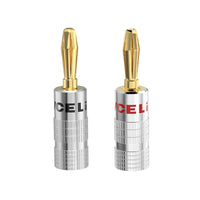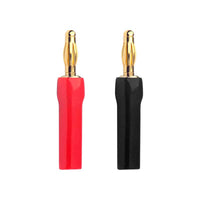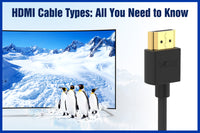You may hear of banana plugs but actually don’t know what they are. Banana plugs are a type of connector used in audio and video equipment for decades. What is a banana plug? Are they necessary in daily life? Are there different types of banana plugs? What are the pros and cons of these plugs? How to install them? You’ll find the answer in this blog.
What is Banana Plug?
A banana connector terminates the end of the exposed wire, making it easy to plug in and out of your receivers. It can be divided into the banana plug and banana socket. The banana plug is named after its shape as the contact tip of it has protruding designs that look like banana leaves. The banana plug is designed with 4 or 9 banana leaves, and the 9-leaf banana plug has a stronger grip than the 4-leaf one. It is noted that there are also 6-leaf banana plugs on the market. This cylindrical-shaped connector is very popular for its reliable and stable connection.
Types of Banana Plugs
The history of the banana plug can date back to the late 1800s, and many variations have been developed over the years. There are various banana plugs on the market to meet different requirements.
Standard Banana Plug
Standard banana plugs are those with shrouded and straight designs, which are the most common type on the market. They have no protective plastic insulation and are often used in low-voltage applications. It should be noted that standard banana plugs can be inserted into both unshrouded or shrouded banana sockets.
Shrouded Banana Plug
Shrouded banana plugs can also be classified into completely shrouded and retractable shrouded ones. A completely shrouded banana plug has insulation and is often used in higher-voltage applications. A retractable sleeve banana plug features a shrouded spring-loaded cover that will slide back when inserted into the banana socket. The retractable sleeve banana plug is popular for its protection and flexibility.
Right-Angled Banana Plug
The right-angled banana plug can be connected to your device at a 90° angle, making this plug great for places where a straight banana plug can be difficult to be inserted. Many people also prefer this banana plug type for its secure and stable connection.
There are also other banana plugs and adapters, such as dual banana plugs and stackable banana plugs. The former features two banana plugs and is designed to be used with two wires without a short circuit; the latter has two holes for a wire exit and the socket.
Banana Plug Size
The most commonly seen banana plugs on the market have a diameter of 4mm. 4 mm connectors are specifically referred to as banana plugs in Europe, but there are also 2mm and 3mm banana plugs on the market. Small or miniature banana plugs do exist based on different needs.
Banana Plug Applications
Banana plugs are used with various audio equipment, providing a neat and secure way to connect the wire to different equipment. Banana plugs are often used for home theaters, sound systems, musical instruments, and testing equipment. They can be used with a variety of audio and video devices:
- Audio and video receivers
- Amplifiers
- Loudspeakers
- ......

Pros and Cons of Banana Plugs
DIYers may prefer buying speaker cables and banana plugs rather than pre-wired cables. You can plan the multi-speaker system and choose the correct length of speaker cable as well as the right banana plug. Overwhelmed by the cable clutter at home? Banana plugs are a cost-effective option to keep your wires organized and neat.
Banana plugs can also make you speaker cables stronger as they can help prevent the cable from bending and moving from the placed position. You know that exposed wires are prone to exterior damage, and these plugs can protect the wire for a more stable connection.
In addition, banana plugs come with different colors. So they can be color coded to help you differentiate various cables.
The only disadvantage of the banana plug is that it may require time to install them, which can be a bit difficult for beginners. But it will be easy if you follow our step-by-step operation guide.
How to Connect Banana Plug?
Before connecting the banana plug, you should consider the length of the speaker wire. It depends on the distance between the receiver and the speaker. Once you have decided on the length, you can follow the following steps.
Step 1: First, separate the wires and operate them with individual wires. Use the wire stripper to strip off the wire insulation of about 15mm.


Step 2: Cut the extra exposed wire according to the length of the plug and then twist the wires into one strand to make it easy to feed through the banana plug.


Step 3: Each pair of wires will use the red and black banana plugs. The red one is usually a positive plug, and the black one is a negative plug. Put the red casing through the wire and then use a screwdriver to loosen the screw.


Step 4: Feed the cable from the bottom of the plug and tighten the screw. Make sure that the cable can stay put.


Step 5: Put the red cover on the plug, and one end of the speaker cable is finished.


Step 6: Repeat the same step on the other end of the cable and put the black cover on the plug.

Step 7: A perfect speaker cable is finished and can be plugged in or out conveniently.

For more information on this topic, you can keep up on our blogs. While VCELINK offers general and basic information for our customers and other visitors to the website, it’s not professional advice.








Be the first one to comment.
Leave a comment